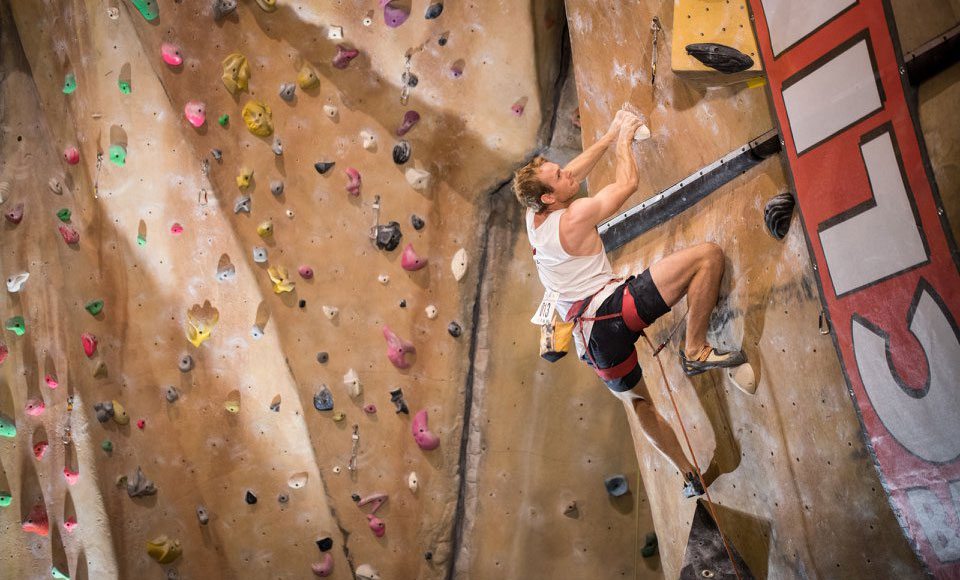Aesthetics is a term often thrown around in bodybuilding circles. It’s a defining trait that underscores every aspect of looking muscular, masculine and physically strong. The keyword here is ‘look’.
When it comes to the underrated sport of rock climbing, some of the strongest men and women are often found strolling around barefooted at your local bouldering gym in a singlet. There’s rarely a protein shake in sight and zero questions like “What are you training today, bro?”.
“Core strength connects your upper and lower body to deliver explosive power that is always controlled.”
Don’t let the exuberant smiles and small congregations under climbing walls fool you though. Guys like Thomas Farrell, one of Australia’s best rock climbers, possess one of the most complete physiques when it comes to usable strength.
And what the hell is usable strength? We’ll explain by showing you how to get it instead. This is a full body workout sport, but not how you know it.
Why Core Strength Is Important
“Core strength the base of everything in the human body,” explains Farrell, who has 17 years worth of rock climbing experience behind him.
“If you don’t have a strong core you can’t connect anything. It connects your upper body to your lower body to deliver explosive power that is always controlled.”
Core strength differs to the strength derived from isolation exercises such as weight lifting or squats in a gym. Think of core training and usable strength as athletic or flexible strength. It’s the kind of strength that is applicable to any given situation rather than a set movement.
“It works the stabiliser muscles which people rarely use and helps with balance, stamina, endurance and muscle reflex.”
This spontaneous movement is the very foundation that rock climbing problems are built on and it carries clear benefits for activating muscles that the body isn’t usually accustomed to.
It’s been debated on the web for a while now but the most complete explanation of usable strength is the combination of physical power, speed, and flexibility to uniformly perform a specific given task.
“Climbing on the wall gets you strong everywhere,” adds Farrell.
“It works the stabiliser muscles which people rarely use and helps with balance, stamina, endurance and muscle reflex.”
Strength Training & Staying Motivated
Whilst climbing is an addictive sport Farrell says that his training now incorporates conventional gym sessions in order to build a complete package that is more resistant to injury.
Here’s what the training schedule of one of Australia’s best climbers looks like:
Monday: Strength work in a conventional gym – 2 hours
- Bench press
- Shoulder press
- Dumbbell front squats
- Dumbbell shoulder press
- Pushups
Tuesday: Climbing based training – 2 hours
- Hang board training (four finger hold, three finger hold, two finger hold, one finger hold)
- Weighted chin-ups
- Sit-ups
- Planking
Wednesday: Conventional gym session – 2 hours
- Cable fly exercises
- Bodyweight squats
- Weighted lunges
Thursday: Climbing session – 2 hours
- Stretching
- Bouldering problems
Friday: Rest day
Saturday: Outdoor climbing session 4 – 8 hours
Sunday: Outdoor climbing session 4 – 8 hours
When Farrell isn’t training for a bouldering competition, he mountain bikes three times a week to breaks things up with cardio and a bit of fun. Most importantly, he’s active almost every day.
His secret to staying motivated and balancing a day job is simple.
“If you say you’re tired from work, you’re not going to train hard anyway. So instead of not going at all, go in and do a less intense job. Your physique and flexibility will thank you for it later,” says Farrell.
“Find enjoyment out of training and you’ll do it. And always think of your end goal and you’ll be accountable for your actions.”
Diet Of An Elite Climber
Diets of serious rock climbers are usually pretty low-key and straight-forward. Avoid or limit junk food and carbs and go for the standard protein and vegetable staple.
Farrell personally avoids processed foods and tries to eat as closely to natural as possible.
“I’d have five meals a day – I do a lot of exercise so I can get away with it,” he says.
“Portion-wise I just space it out. I’m not so strict on eating more during the day or night. Just an equal number throughout the day. If I’m coming up to a comp I won’t drink. Other than that it’s all good.”
Avoiding Injuries & Staying Fit You Age
Talk to any seasoned rock climber and they could point out a list of sustained injuries from joint pains to full blown torn ACLs and muscle tears.
“As I’ve gotten a bit older I’ve had to be bit careful,” admits Farrell.
“You can get tendonitis issues in your elbow for a few years from climbing too much.”
His recommendations for staying injury-free for as long as possible are simple.
- Conventional gym training – “With climbing you’re always pulling and rarely pushing. You can get imbalanced doing that so I find hitting the regular gym super important. Since I’ve been doing weights it’s helped keep me injury free.”
- Stretching – “I was lucky when I was young and being flexible, but as you age you need to stretch more to prevent injury. There’s no way around it.”
- Try other sports you enjoy – “Supplementing a sport in between can give you a break from climbing whilst still keeping you active. It’s necessary to help your body recover and strengthen.”
RELATED: Lacking Muscles? You Need To Eat Like This If You Want To Look Like Tim Robards
